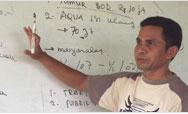From Kent Hill, USAID Assistant Administrator for Global Health
On the Observance of World Tuberculosis Day 2008
FOR IMMEDIATE RELEASE
March 24, 2008
Press Office: 202-712-4320
Public Information: 202-712-4810
www.usaid.gov
WASHINGTON, D.C. - Although a cure for Tuberculosis (TB) has existed for more than half a century, TB remains one of three leading causes of death worldwide due to infectious disease. TB kills approximately 1.6 million people each year, while HIV/AIDS claims more than two million lives each year, and malaria kills more than one million people each year.
The U.S. Agency for International Development (USAID) has a clear and proven strategy to detect and treat people who suffer from TB. We are helping to make progress in prevention and control, and in 2005, the rate of new TB cases worldwide leveled off for the first time since the World Health Organization (WHO) began collecting data about the disease. Globally, the target of successfully treating 85 percent of TB cases has been met, and we continue to make steady progress toward the target of detecting 70 percent of all cases.
USAID is the lead U.S. government agency in international TB control programs, supporting efforts in 37 countries. USAID works in close partnership with the President's Emergency Plan for HIV/AIDS Relief, which is making significant investments in TB and HIV co-infection, with the Centers for Disease Control and Prevention, and with the National Institutes for Health.
The core of USAID's work in TB is focused on building the capacity of developing countries to implement effective programs to combat and control TB. Our programs support the implementation of the WHO Global Plan to Stop TB, which works to expand and strengthen basic TB programs as the key intervention for preventing and controlling drug-resistant TB. USAID is a founding member of the Stop TB partnership, which is comprised of a network of more than 500 international organizations, countries, donors from the public and private sectors, and nongovernmental and governmental organizations. Working closely with our partners, USAID recently increased the capacity to deliver Directly Observed Short Course (DOTS) treatment in more than 40 countries, including hard hit countries such as India, Indonesia, South Africa, and Russia
Our efforts are saving lives and making a real difference in affected communities, but much work remains to be done. The best approach we have to diagnose TB in resource limited settings is more than 100 years old, and the approach is only effective half of the time, even less so in HIV positive patients where TB is deadliest.
In addition, Eastern Europe and Asia are fighting an increasing prevalence of multiple drug resistance (MDR) to proven drug therapies. According to a new WHO report, MDR-TB rates are at their highest ever. MDR-TB requires treatment for 18 to 24 months with second-line drugs that are much less effective, poorly tolerated by the patient, and far more costly. Nearly 500,000 new cases of MDR-TB emerged globally in 2006.
Extensively drug-resistant (XDR) TB, a subset of MDR-TB caused by bacteria strains that are resistant to first-line and the most effective second-line drugs, has been recorded in 45 countries. XDR-TB is a virtually untreatable form of the respiratory disease. The true scale of the problem remains almost unknown because few countries are equipped to diagnose it.
Africa has the highest incidence of TB in the world, and Sub-Saharan Africa is battling the combined effects of TB and HIV/AIDS. TB is the leading cause of death for AIDS patients. In parts of Sub-Saharan Africa, rates of HIV co-infection among TB patients often exceed 50 percent.
The recent WHO report finds that some countries are making strides against the TB/HIV co-epidemic. Almost 700,000 TB patients were tested for HIV in 2006, up from 22,000 in 2002.
In addition to our work to strengthen basic TB programs, USAID has moved quickly to help countries and international partners respond to these new threats by assisting with drug-resistance surveys, building laboratory capacity to detect resistant strains, expanding country-level programs to treat MDR-TB patients, and supporting the Green Light Committee, which helps ensure that countries have effective programs to manage MDR-TB patients and second-line anti-TB drugs.
The threats of MDR-TB and XDR-TB have re-focused attention on the urgent need to develop more accurate and rapid diagnostics for TB, to develop new drugs effective against resistant strains, and to develop an effective TB vaccine. The U.S. is committed to work with country governments and the international community to successfully implement the WHO Global Plan to Stop TB. Together, we can continue to bring hope to the millions of people suffering from TB and work toward curing TB once and for all.
For more information on USAID's Global Health programs, please visit www.usaid.gov.
The American people, through the U.S. Agency for International Development, have provided economic and humanitarian assistance worldwide for nearly 50 years.
Back to Top ^
|


